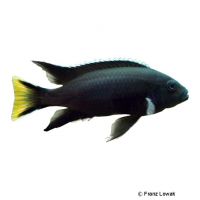Acei Cichlid Itungi (Pseudotropheus sp. 'Acei Itungi')
| Acei Cichlid Itungi Pseudotropheus sp. 'Acei Itungi' | |
|---|---|
| Name | Acei Cichlid Itungi |
| Name Lat. | Pseudotropheus sp. 'Acei Itungi' |
| Family | Cichlids |
| Family lat. | Cichlidae |
| Order | Cichlids |
| Order lat. | Cichliformes |
| Origin | Lake Malawi |
| Habitat | Sandy intermediate zone |
| Diet | Omnivore, aufwuchs |
| pH | 7.5-8.8 |
| Behavior | Semi-aggressive |
| Keeping | Harem, group |
| Care Level | Moderate |
| Reproduction | Mouthbrooder |
| Breeding | Simple |
| Life Span | 5-8 years |
| Protection | No |
| Metric Units | |
| Size | 12-14 cm |
| Temperature | 24-28 °C |
| Hardness | 10-25 °dH |
| Aquarium | ~ 400 l |
| US Units | |
| Size | 4.7"-5.5" |
| Temperature | 75-82 °F |
| Hardness | 178-445 ppm |
| Aquarium | ~ 100 gal |
Distribution and habitat
The Acei Malawi Cichlid Itungi is a locality variant of the Acei Malawi Cichlids. They are found exclusively (endemically) in western Lake Malawi, from Ngara to Senga Bay (Malawi). These mbunas usually reside among sunken trees and branches.
Maintenance
The aquarium setup should have rock structures reaching to the water surface with plenty of hiding places (crevices, caves, shelters), with roots and free sand areas, as well as plenty of free swimming space
No ammonia, ammonium and nitrite should be detectable, the nitrate value should not exceed 100 mg/l. To ensure the water quality and oxygen content, a filter and heater adapted to the aquarium size is required, as well as lighting for the species-appropriate day-night rhythm of the animals.
Diet
They feed mainly on the plant cover (growth) and the microorganisms contained therein, as well as on plankton. The food supply consists of live, frozen and dry food. For a balanced diet, feed once daily with a high-quality dry food for Malawi cichlids (flakes, granules, pellets) as well as cyclops, daphnia, artemia and plankton (live or frozen). In addition, they also need vegetable food, such as algae leaves and commercially available green food (kelp, spirulina)
Only feed as much as will be eaten within a few minutes. A regular and varied diet promotes health and increases resistance.
Behaviour and compatibility
They are relatively peaceful and should be kept in a harem, one male with several females. Keeping multiple harems is only recommended in a larger and richly structured tank. These cichlids should only be socialized with other cichlids from Lake Malawi, especially from the mbuna group
Basically, only compatible fish species with similar demands on water conditions and water temperature should be socialized.
Sex dimorphism
The sexes are difficult to distinguish. The females are usually somewhat smaller than the males, which have a pointed dorsal fin and are somewhat more strongly colored.
Reproduction and breeding
They are maternal mouth brooders. Immediately after spawning on a rock, the females take the eggs into their throat sac for mouth brooding. They keep the fry in their throat sac even after hatching. After 3-4 weeks, the fry are released and brood care ends. Throughout brood care, the female does not consume food.
Fry must be fed several times a day with special rearing food. In community tanks breeding is hardly possible, because the fry are easy prey.
Important
Different site variants of Pseudotropheus sp. 'Acei' should not be maintained together, as they may interbreed (hybridize).
The well-being of the fish should be monitored regularly. Temperature should be checked daily, pH, hardness and nitrate levels at least fortnightly. Regular partial water changes are recommended, even when contaminant levels have not yet reached the upper limit. Sudden changes in water quality should be avoided. Newly introduced fish must be accustomed slowly to the water in the aquarium.
Further literature can be found in your pet store.
References
Text: petdata; Image: Franz Lowak
Source: BMELV (1998): Tierschutzgutachten - Haltung von Zierfischen (Süßwasser); ENGELMANN (2005): Zootierhaltung - Tiere in menschlicher Obhut: Fische, Verlag Harri Deutsch
- Gemäß § 21 Abs. 5 Tierschutzgesetz idgF
